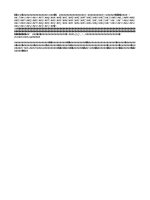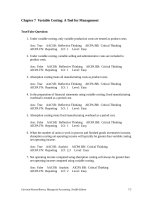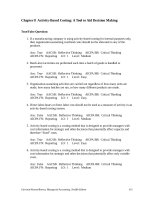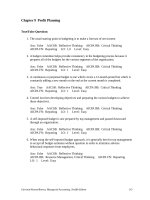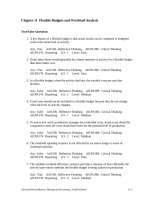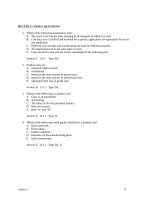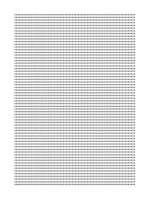Test bank managerial accounting by hilton 9e chapter07
Bạn đang xem bản rút gọn của tài liệu. Xem và tải ngay bản đầy đủ của tài liệu tại đây (351.78 KB, 36 trang )
MULTIPLE CHOICE QUESTIONS
1. The relationship between cost and activity is termed:
A. cost estimation.
B. cost prediction.
C. cost behavior.
D. cost analysis.
E. cost approximation.
Answer: C LO: 1 Type: RC
2. Which of the following costs changes in direct proportion to a change in the activity level?
A. Variable cost.
B. Fixed cost.
C. Semivariable cost.
D. Step-variable cost.
E. Step-fixed cost.
Answer: A LO: 2 Type: RC
3. Montgomery Company has a variable selling cost. If sales volume increases,
how will the total variable cost and the variable cost per unit behave?
Total Variable Cost
Variable Cost Per Unit
A. Increase
Increase
B. Increase
Remain constant
C. Increase
Decrease
D. Remain constant
Decrease
E.
Decrease
Increase
Answer: B LO: 2 Type: RC
4. What type of cost exhibits the behavior that follows?
Manufacturing
Volume (Units)
50,000
70,000
A.
B.
C.
D.
E.
Cost Per Unit
$1.95
1.95
Variable cost.
Fixed cost.
Semivariable cost.
Discretionary fixed cost.
Step-fixed cost.
Answer: A LO: 2 Type: N
164
Hilton, Managerial Accounting, Seventh Edition
5. Plaza Corporation observed that when 25,000 units were sold, a particular cost amounted to
$70,000, or $2.80 per unit. When volume increased by 15%, the cost totaled $80,500 (i.e., $2.80
per unit). The cost that Plaza is studying can best be described as a:
A. variable cost.
B. fixed cost.
C. semivariable cost.
D. discretionary fixed cost.
E. step-fixed cost.
Answer: A LO: 2 Type: N
6. A company observed a decrease in the cost per unit. All other things being equal, which of the
following is probably true?
A. The company is studying a variable cost, and total volume has increased.
B. The company is studying a variable cost, and total volume has decreased.
C. The company is studying a fixed cost, and total volume has increased.
D. The company is studying a fixed cost, and total volume has decreased.
E. The company is studying a fixed cost, and total volume has remained constant.
Answer: C LO: 2 Type: N
7. Webster has the following budgeted costs at its anticipated production level (expressed in hours):
variable overhead, $150,000; fixed overhead, $240,000. If Webster now revises its anticipated
production slightly downward, it would expect:
A. total fixed overhead of $240,000 and a lower hourly rate for variable overhead.
B. total fixed overhead of $240,000 and the same hourly rate for variable overhead.
C. total fixed overhead of $240,000 and a higher hourly rate for variable overhead.
D. total variable overhead of less than $150,000 and a lower hourly rate for variable overhead.
E. total variable overhead of less than $150,000 and a higher hourly rate for variable overhead.
Answer: B LO: 2 Type: N
8. What type of cost exhibits the behavior that follows?
Manufacturing
Volume (Units)
50,000
80,000
A.
B.
C.
D.
E.
Total
Cost
$150,000
150,000
Cost
Per Unit
$3.00
1.88
Variable cost.
Fixed cost.
Semivariable cost.
Step-variable cost.
Mixed cost.
Answer: B LO: 2 Type: N
165
Hilton, Managerial Accounting, Seventh Edition
9. When graphed, a typical variable cost appears as:
A. a horizontal line.
B. a vertical line.
C. a u-shaped line.
D. a diagonal line that slopes downward to the right.
E. a diagonal line that slopes upward to the right.
Answer: E LO: 2 Type: RC
10. Norman Company pays a sales commission of 5% on each unit sold. If a graph is prepared, with
the vertical axis representing per-unit cost and the horizontal axis representing units sold, how
would a line that depicts sales commissions be drawn?
A. As a straight diagonal line, sloping upward to the right.
B. As a straight diagonal line, sloping downward to the right.
C. As a horizontal line.
D. As a vertical line.
E. As a curvilinear line.
Answer: C LO: 2 Type: N
11. When graphed, a typical fixed cost appears as:
A. a horizontal line.
B. a vertical line.
C. a u-shaped line.
D. a diagonal line that slopes downward to the right.
E. a diagonal line that slopes upward to the right.
Answer: A LO: 2 Type: RC
12. Costs that remain the same over a wide range of activity, but jump to a different amount outside
that range, are termed:
A. step-fixed costs.
B. step-variable costs.
C. semivariable costs.
D. curvilinear costs.
E. mixed costs.
Answer: A LO: 2 Type: RC
13. Straight-line depreciation is a typical example of a:
A. variable cost.
B. step-variable cost.
C. fixed cost.
D. mixed cost.
E. curvilinear cost.
Answer: C LO: 2 Type: RC
Chapter 7
166
14. Which of the following choices denotes the typical cost behavior of
advertising and sales commissions?
Advertising
Sales Commissions
A. Variable
Variable
B. Variable
Fixed
C. Fixed
Variable
D. Fixed
Fixed
E. Semivariable
Variable
Answer: C LO: 2 Type: N
15. Douglas Corporation recently produced and sold 100,000 units. Fixed costs at this level of
activity amounted to $50,000; variable costs were $100,000. How much cost would the company
anticipate if during the next period it produced and sold 102,000 units?
A. $150,000.
B. $151,000.
C. $152,000.
D. $153,000.
E. Some other amount not listed above.
Answer: C LO: 2 Type: A
16. Extron, Inc., has only variable costs and fixed costs. A review of the company's records disclosed
that when 100,000 units were produced, fixed manufacturing costs amounted to $200,000 and the
cost per unit manufactured totaled $5. On the basis of this information, how much cost would the
firm anticipate at an activity level of 97,000 units?
A. $485,000.
B. $491,000.
C. $494,000.
D. $500,000.
E. Some other amount not listed above.
Answer: B LO: 2 Type: A
17. A review of Parry Corporation's accounting records found that at a volume of 90,000 units, the
variable and fixed cost per unit amounted to $8 and $4, respectively. On the basis of this
information, what amount of total cost would Parry anticipate at a volume of 85,000 units?
A. $1,020,000.
B. $1,040,000.
C. $1,060,000.
D. $1,080,000.
E. Some other amount not listed above.
Answer: B LO: 2 Type: A
167
Hilton, Managerial Accounting, Seventh Edition
18. Each of Davidson's production managers (annual salary cost, $45,000) can oversee 60,000
machine hours of manufacturing activity. Thus, if the company has 50,000 hours of
manufacturing activity, one manager is needed; for 75,000 hours, two managers are needed; for
125,000 hours, three managers are needed; and so forth. Davidson's salary cost can best be
described as a:
A. variable cost.
B. semivariable cost.
C. step-variable cost.
D. fixed cost.
E. step-fixed cost.
Answer: E LO: 2 Type: N
19. A cost that has both a fixed and variable component is termed a:
A. step-fixed cost.
B. step-variable cost.
C. semivariable cost.
D. curvilinear cost.
E. discretionary cost.
Answer: C LO: 2 Type: RC
20. A mixed cost is often known as a:
A. semivariable cost.
B. step-fixed cost.
C. variable cost.
D. curvilinear cost.
E. discretionary cost.
Answer: A LO: 2 Type: RC
21. Richard Hamilton has a fast-food franchise and must pay a franchise fee of $35,000 plus 3% of
gross sales. In terms of cost behavior, the fee is a:
A. variable cost.
B. fixed cost.
C. step-fixed cost.
D. semivariable cost.
E. curvilinear cost.
Answer: D LO: 2 Type: N
Chapter 7
168
22. Which of the following are examples of a mixed cost?
I.A building that is used for both manufacturing and sales activities.
II.An employee's compensation, which consists of a flat salary plus a commission.
III.Depreciation that relates to five different machines.
IV.Maintenance cost that must be split between sales and administrative offices.
A.
B.
C.
D.
E.
I only.
II only.
I and III.
I, III, and IV.
I, II, III, and IV.
Answer: B LO: 2 Type: N
23. Which of the following costs exhibits both decreasing and increasing marginal costs over a
specific range of activity?
A. Semivariable cost.
B. Curvilinear cost.
C. Step-fixed cost.
D. Step-variable cost.
E. Fixed cost.
Answer: B LO: 2 Type: RC
24. The relevant range is that range of activity:
A. where a company achieves its maximum efficiency.
B. where units produced equal units sold.
C. where management expects the firm to operate.
D. where the firm will earn a profit.
E. where expected results are abnormally high.
Answer: C LO: 3 Type: RC
25. Within the relevant range of activity, costs:
A. can be estimated with reasonable accuracy.
B. can be expected to change radically.
C. exhibit decreasing marginal cost patterns.
D. exhibit increasing marginal cost patterns.
E. cannot be estimated satisfactorily.
Answer: A LO: 3 Type: RC
169
Hilton, Managerial Accounting, Seventh Edition
26. Within the relevant range, a curvilinear cost function can sometimes be graphed as a:
A. straight line.
B. jagged line.
C. vertical line.
D. curved line.
E. horizontal line.
Answer: A LO: 3 Type: RC
27. As a firm begins to operate outside the relevant range, the accuracy of cost
estimates for fixed and variable costs:
Variable
Fixed
A. increases
increases
B. increases
decreases
C. decreases
increases
D. decreases
decreases
E. decreases
remains unchanged
Answer: D LO: 3 Type: N
28. A variable cost that has a definitive physical relationship to the activity measure is called a(n):
A. discretionary cost.
B. engineered cost.
C. managed cost.
D. programmed cost.
E. committed cost.
Answer: B LO: 4 Type: RC
29. Costs that result from an organization's ownership or use of facilities and its basic organizational
structure are termed:
A. discretionary fixed costs.
B. committed fixed costs.
C. discretionary variable costs.
D. committed variable costs.
E. engineered costs.
Answer: B LO: 4 Type: RC
30. Property taxes are an example of a(n):
A. committed fixed cost.
B. committed variable cost.
C. discretionary fixed cost.
D. discretionary variable cost.
E. engineered cost.
Answer: A LO: 4 Type: RC
Chapter 7
170
31. Which of the following is not an example of a committed fixed cost?
A. Property taxes.
B. Depreciation on buildings.
C. Salaries of management personnel.
D. Outlays for advertising programs.
E. Equipment rental costs.
Answer: D LO: 4 Type: RC
32. Committed fixed costs would include:
A. advertising.
B. research and development.
C. depreciation on buildings and equipment.
D. contributions to charitable organizations.
E. expenditures for direct labor.
Answer: C LO: 4 Type: RC
33. Amounts spent for charitable contributions are an example of a(n):
A. committed fixed cost.
B. committed variable cost.
C. discretionary fixed cost.
D. discretionary variable cost.
E. engineered cost.
Answer: C LO: 4 Type: RC
34. Which of the following would not typically be classified as a discretionary fixed cost?
A. Equipment depreciation.
B. Employee development (education) programs.
C. Advertising.
D. Outlays for research and development.
E. Charitable contributions.
Answer: A LO: 4 Type: RC
35. Which of the following choices correctly classifies a committed fixed cost and
a discretionary fixed cost?
Committed
Discretionary
A. Promotion
Management salaries
B. Building depreciation
Charitable contributions
C. Management training
Property taxes
D. Equipment rentals
Equipment depreciation
E. Research and development
Advertising
Answer: B LO: 4 Type: RC
171
Hilton, Managerial Accounting, Seventh Edition
36. Which type of fixed cost (1) tends to be more long-term in nature and (2) can
be cut back more easily in bad economic times without doing serious harm to
organizational goals and objectives?
Long Term in
Can be Cut Back More Easily In
Nature
Bad Economic Times
A. Committed
Committed
B. Committed
Discretionary
C. Discretionary
Committed
D. Discretionary
Discretionary
E. Committed
No difference between
committed and discretionary
Answer: B LO: 4 Type: N
37. High-tech automation combined with a downsizing of a company's hourly labor force often
results in:
A. increased fixed costs and increased variable costs.
B. increased fixed costs and reduced variable costs.
C. reduced fixed costs and increased variable costs.
D. reduced fixed costs and reduced variable costs.
E. increased discretionary fixed costs and reduced committed fixed costs.
Answer: B LO: 4 Type: RC
38. Which of the following techniques is not used to analyze cost behavior?
A. Least-squares regression.
B. High-low method.
C. Visual-fit method.
D. Linear programming.
E. Multiple regression.
Answer: D LO: 5, 6 Type: RC
39. The high-low method and least-squares regression are used by accountants to:
A. evaluate divisional managers for purposes of raises and promotions.
B. choose among alternative courses of action.
C. maximize output.
D. estimate costs.
E. control operations.
Answer: D LO: 5 Type: RC
Chapter 7
172
40. Which of the following statements about the visual-fit method is (are) true?
I.The method results in the creation of a scatter diagram.
II.The method is not totally objective because of the manner in which the cost line is determined.
III.The method is especially helpful in the determination of outliers.
A.
B.
C.
D.
E.
I only.
II only.
I and II.
I and III.
I, II, and III.
Answer: E LO: 5 Type: RC
41. The nonstatistical method of cost estimation that calls for the creation of a scatter diagram is the:
A. least-squares regression method.
B. high-low method.
C. visual-fit method.
D. account analysis method.
E. multiple regression method.
Answer: C LO: 5 Type: RC
42. Which of the following methods of cost estimation relies on only two data points?
A. Least-squares regression.
B. The high-low method.
C. The visual-fit method.
D. Account analysis.
E. Multiple regression.
Answer: B LO: 5 Type: RC
Use the following to answer questions 43-44:
Swanson and Associates presently leases a copy machine under an agreement that calls for a fixed fee
each month and a charge for each copy made. Swanson made 7,000 copies and paid a total of $360 in
March; in May, the firm paid $280 for 5,000 copies. The company uses the high-low method to analyze
costs.
43. Swanson's variable cost per copy is:
A. $0.040.
B. $0.051.
C. $0.053.
D. $0.056.
E. an amount other than those given above.
Answer: A LO: 5 Type: A
173
Hilton, Managerial Accounting, Seventh Edition
44. Swanson's monthly fixed fee is:
A. $80.
B. $102.
C. $106.
D. $112.
E. an amount other than those given above.
Answer: A LO: 5 Type: A
Use the following to answer questions 45-47:
Atlanta, Inc., which uses the high-low method to analyze cost behavior, has determined that machine
hours best explain the company's utilities cost. The company's relevant range of activity varies from a
low of 600 machine hours to a high of 1,100 machine hours, with the following data being available for
the first six months of the year:
Month
January
February
March
April
May
June
Utilities
$8,700
8,360
8,950
9,360
9,625
9,150
Machine Hours
800
720
810
920
950
900
45. The variable utilities cost per machine hour is:
A. $0.18.
B. $4.50.
C. $5.00.
D. $5.50.
E. an amount other than those listed above.
Answer: D LO: 5 Type: A
46. The fixed utilities cost per month is:
A. $3,764.
B. $4,400.
C. $4,760.
D. $5,100.
E. an amount other than those listed above.
Answer: B LO: 5 Type: A
Chapter 7
174
47. Using the high-low method, the utilities cost associated with 980 machine hours would be:
A. $9,510.
B. $9,660.
C. $9,700.
D. $9,790.
E. an amount other than those listed above.
Answer: D LO: 5 Type: A
48. Hitchcock, Inc., uses the high-low method to analyze cost behavior. The company observed that
at 12,000 machine hours of activity, total maintenance costs averaged $7.00 per hour. When
activity jumped to 15,000 machine hours, which was still within the relevant range, the average
cost per machine hour totaled $6.40. On the basis of this information, the variable cost per
machine hour was:
A. $4.00.
B. $6.40.
C. $6.70.
D. $7.00.
E. an amount other than those listed above.
Answer: A LO: 5 Type: A
49. Northridge, Inc., uses the high-low method to analyze cost behavior. The company observed that
at 20,000 machine hours of activity, total maintenance costs averaged $10.50 per hour. When
activity jumped to 24,000 machine hours, which was still within the relevant range, the average
cost per machine hour totaled $9.75. On the basis of this information, the company's fixed
maintenance costs were:
A. $24,000.
B. $90,000.
C. $210,00.
D. $234,000.
E. an amount other than those listed above.
Answer: B LO: 5 Type: A
175
Hilton, Managerial Accounting, Seventh Edition
50. The following data relate to the Hodges Company for May and August of the current year:
May
10,000
$260,000
Maintenance hours
Maintenance cost
August
12,000
$300,000
May and August were the lowest and highest activity levels, and Hodges uses the high-low
method to analyze cost behavior. Which of the following statements is true?
A. The variable maintenance cost is $25 per hour.
B. The variable maintenance cost is $25.50 per hour.
C. The variable maintenance cost is $26 per hour.
D. The fixed maintenance cost is $60,000 per month.
E. More than one of the above statements is true.
Answer: D LO: 5 Type: A
Use the following to answer questions 51-53:
Yang Manufacturing, which uses the high-low method, makes a product called Yin. The company incurs
three different cost types (A, B, and C) and has a relevant range of operation between 2,500 units and
10,000 units per month. Per-unit costs at two different activity levels for each cost type are presented
below.
5,000 units
7,500 units
Type A
$4
$4
Type B
$9
$6
Type C
$4
$3
Total
$17
$13
51. The cost types shown above are identified by behavior as:
Type A
Type B
Type C
A. Fixed
Variable
Semivariable
B. Fixed
Semivariable
Variable
C. Variable
Semivariable
Fixed
D. Variable
Fixed
Semivariable
E. Semivariable
Variable
Fixed
Answer: D LO: 2, 5 Type: A, N
52. If Yang produces 10,000 units, the total cost would be:
A. $90,000.
B. $100,000.
C. $110,000.
D. $125,000.
E. an amount other than those given above.
Answer: C LO: 5 Type: A, N
Chapter 7
176
53. The cost formula that expresses the behavior of Yang's total cost is:
A. Y = $0 + $17X.
B. Y = $20,000 + $13X.
C. Y = $40,000 + $9X.
D. Y = $45,000 + $4X.
E. Y = $60,000 + $5X.
Answer: E LO: 5 Type: A
54. In regression analysis, the variable that is being predicted is known as the:
A. independent variable.
B. dependent variable.
C. explanatory variable.
D. interdependent variable.
E. functional variable.
Answer: B LO: 5 Type: RC
55. Mohawk Products has determined that the number of machine hours worked (MH) drives the
amount of manufacturing overhead incurred (MOH). On the basis of this relationship, a staff
analyst has constructed the following regression equation:
MOH = 240,000 + 8MH
Which of the choices correctly depicts the nature of Mohawk's variables?
Dependent
Independent
A.
MOH
MOH
B.
MOH
MH
C.
MH
MOH
D.
MH
MH
E.
8
240,000
Answer: B LO: 5 Type: N
56. Checkers Corporation, which uses least-squares regression analysis, has derived the following
regression equation for estimates of manufacturing overhead: Y = 495,000 + 5.65X. Which of the
following statements is true if the primary cost driver is machine hours?
A. Total manufacturing overhead is represented by the variable "X."
B. The company anticipates $495,000 of fixed manufacturing overhead.
C. "X" is commonly known as the dependent variable.
D. "X" represents the number of machine hours.
E. Both "B" and "D" are true.
Answer: E LO: 5 Type: N
177
Hilton, Managerial Accounting, Seventh Edition
57. Boulder, Inc., recently conducted a least-squares regression analysis to predict selling expenses.
The company has constructed the following regression equation: Y = 329,000 + 7.80X. Which of
the following statements is false if the primary cost driver is number of units sold?
A. The company anticipates $329,000 of fixed selling expenses.
B. "Y" represents total selling expenses.
C. The company expects both variable and fixed selling expenses.
D. For each unit sold, total selling expenses will increase by $7.80.
E. "X" represents the number of hours worked during the period.
Answer: E LO: 2, 5 Type: N
58. Tempe, Inc., is studying marketing cost and sales volume, and has generated the following
information by use of a scatter diagram and a least-squares regression analysis:
Variable cost per unit sold
Total monthly fixed cost
Scatter Diagram
$6.50
$45,000
Regression Analysis
$6.80
$42,500
Tempe is now preparing an estimate for monthly sales of 18,000 units. On the basis of the data
presented, compute the most accurate sales forecast possible.
A. $159,500.
B. $162,000.
C. $164,900.
D. $167,400.
E. An amount other than those listed above.
Answer: C LO: 5 Type: A, N
59. Waller Enterprises has determined that three variables play a key role in determining company
revenues. To arrive at an objective forecast of revenues for the next accounting period, Waller
should use:
A. simple regression.
B. multiple regression.
C. a scatter diagram.
D. complex regression.
E. the high-low method.
Answer: B LO: 6 Type: N
60. Which of the following tools is not associated with cost estimation?
A. Least-squares regression.
B. Multiple regression.
C. Inversion equations.
D. Time and motion (engineering) studies.
E. Learning curves.
Answer: C LO: 5, 6 Type: RC
Chapter 7
178
61. A staff assistant at Washington Corporation recently determined that the first four units completed
in a new manufacturing process took 800 hours to complete, or an average of 200 hours per unit.
The assistant also found that when the cumulative output produced doubles, the average labor
time declines by 20%. On the basis of this information, how many total hours would Washington
use if it produces 16 units?
A. 128.
B. 160.
C. 1,280.
D. 2,048.
E. An amount other than those listed above.
Answer: D LO: 6 Type: A
62. Which of the following is not an issue in the collection of data for cost estimation?
A. Outliers.
B. Missing data.
C. Mismatched time periods.
D. Inflation.
E. All of the above are issues in data collection.
Answer: E LO: 7 Type: RC
63. A high R2 measure in regression analysis is preferred because:
A. it indicates a good fit of the regression line through the data points.
B. it shows that a great deal of the change in the dependent variable is explained by change in
the independent variable.
C. it means that the independent variable is a good predictor of the dependent variable.
D. it means that the cost analyst can be relatively confident in his or her cost predictions.
E. all of the preceding statements are true.
Answer: E LO: 8 Type: RC
179
Hilton, Managerial Accounting, Seventh Edition
EXERCISES
Cost Behavior Patterns
64. Consider the graphs that follow (the horizontal axis represents activity; the vertical axis
represents total dollars).
Required:
For items A-I that follow, choose the graph that best represents the cost behavior pattern
described. Note: Graphs can be used more than once.
A. Straight-line depreciation on machinery.
A. The cost of chartering a private airplane. The cost is $800 per hour for the first 6 hours of
a flight; it then drops to $600 per hour.
B. The wages of table service personnel in a restaurant. The employees are part-time
workers who can be called upon for as little as 4 hours at a time.
C. Weekly wages of store clerks who work 40 hours each week. One clerk is hired for every
125 sales made during the month.
D. The cost of tires used in the production of trucks.
B. Outbound shipping charges that increase at a decreasing rate as sales rise because the
firm can use more efficient modes of transportation (e.g., full trailer loads, full rail cars,
etc.). Gradually, however, at high levels of sales, freight costs start to increase at an
increasing rate, which reflects more transactions made to customers in far-away locations.
C. Equipment leasing costs that are computed at $2 per machine hour worked. The
company pays a maximum of $120,000 per month.
Chapter 7
180
D. The monthly cost of a franchise fee for a fast-food restaurant. The franchisee must pay
$20,000 plus 5% of gross dollar sales.
E. The cost of electricity during peak demand periods, which is based on the following
schedule:
Up to 20,000 kilowatt hours (KWH): $4,000
Above 20,000 kilowatt hours: $4,000 + $0.02 per KWH
LO: 2 Type: N
Answer:
A. 2 B. 4
C. 7
D. 5
E. 1
F. 8
G. 9
H. 6
I. 3
Cost Behavior Patterns
65. Resource Consulting is studying the costs of several clients, and has found that the accompanying
graphs appear as follows:
1.
2.
3.
4.
5.
6.
A straight line that gradually slopes upward to the right
A curvilinear line that gradually slopes upward to the right
A straight line that is parallel to the graph’s horizontal axis
A straight line that gradually slopes downward to the right
A curvilinear line that gradually slopes downward to the right
A straight line that gradually slopes upward to the right and then, at a specific point,
flattens out to run parallel to the horizontal axis
7. A series of straight lines that appear to resemble a set of steps
8. A straight line that runs parallel to the graph’s horizontal axis and then, at a specific point,
drops to a lower level
Unless told otherwise, assume that the horizontal axis represents total activity and the vertical
axis represents total cost.
Required:
For items A-F, indicate the number of the graph that best represents the cost behavior pattern
described. Note: Graphs can be used more than once, and not all graphs need be used.
A. The salary cost of lab technicians employed at a clinic. One technician is needed for every
1,500 patients serviced.
B. The cost of glass used by a manufacturer of automobile windshields.
C. A profit-sharing bonus that is paid to the associate director of a firm that conducts
professional-development courses for executives. The bonus is based on revenues from
courses that are being run, subject to a maximum amount each year.
D. Flood insurance premiums that are paid by Reliable Manufacturing, which operates a
production facility close to a river.
181
Hilton, Managerial Accounting, Seventh Edition
E. The paper cost that is used in the production of a textbook. Note: Assume that for this part
only, the graph’s vertical axis represents the cost per unit rather than total cost.
F. Tariffs that are paid on products shipped overseas. For one particular country, if fewer than
15,000 units are shipped, the client must pay $4 per unit. The tariff is raised by $1 according
to the following schedule:
15,000 to 29,999 units
30,000 to 44,999 units
45,000 to 59,999 units
$5 per unit
$6 per unit
$7 per unit
LO: 2 Type: N
Answer:
A. 7 B. 1
C. 6
D. 3
E. 3
F. 2
Cost Classification, Cost Behavior
66. Consider the six costs that follow.
1.
2.
3.
4.
5.
6.
Advertising and promotion costs of a do-it-yourself retailer
Surgical supplies used in a hospital's operating room
Aircraft depreciation charges of an airline
Utility charges that include a minimum-use fee, for a small business
Annual business licensing fee paid by a daycare center
Truck fuel consumed by a road construction company
Required:
A. Classify each of these costs as variable, committed fixed, discretionary fixed, or semivariable.
B. Briefly describe the behavior of a per-unit variable cost as activity changes.
C. What elements are present in a semivariable cost that cause it to behave in a semivariable
manner?
D. Generally speaking, does management have more flexibility when dealing with committed
fixed costs or discretionary fixed costs?
LO: 2, 4 Type: RC, N
Answer:
A.
1.
2.
3
.
4
.
5
.
6.
Discretionary fixed
Variable
Committed fixed
Semivariable
Committed fixed
Variable
B.
Per-unit variable costs remain constant as activity levels change.
C.
Semivariable, or mixed costs, contain both a variable and fixed component.
Chapter 7
182
D.
183
Discretionary fixed costs
Hilton, Managerial Accounting, Seventh Edition
Cost Classification, Cost Equation
67. Sunshine Valley Meat Company produces one of the best sausage products in Pennsylvania. The
company's controller compiled the following information by analyzing the accounting records:
1.
2.
3.
4.
Meat costs the company $3.25 per pound of sausage produced.
Compensation of production employees is $2.25 per pound of sausage produced.
Supervisory salaries total $23,000 per month.
The company incurs utility costs of $9,000 per month plus $0.35 per pound of sausage
produced.
5. Insurance and property taxes average $6,400 per month.
Required:
A. Classify each cost as variable, fixed, or semivariable.
B. Write a formula to express the behavior of the firm's production costs. (Use the form Y = a +
bX, where X denotes the quantity of sausage produced.)
LO: 2, 5 Type: A, N
Answer:
A. 1. Variable
2. Variable
3. Fixed
4. Semivariable
5. Fixed
B.
Supervision
Fixed utilities
Insurance and
property taxes
Total fixed
$23,000
9,000
6,400
$38,400
Meat
Labor
Variable utilities
Total variable
$3.25
2.25
0.35
$5.85
Production cost per month: Y = $38,400 + $5.85X
Chapter 7
184
Cost Analysis, Behavior, and Classification
68. Viscount Corporation has a machining capacity of 200,000 hours per year. Utilization of capacity
is normally 75%; it has been as low as 40% and as high as 90%. An analysis of the accounting
records revealed the following selected costs:
Cost A:
Total
Per hour
Cost B:
Total
Per hour
Cost C:
Total
Per hour
At a 40%
Utilization Rate
At a 90%
Utilization Rate
$440,000
$5.50
$ 440,000
?
?
$10.80
$1,944,000
$10.80
$680,000
$8.50
$1,330,000
$7.39
Viscount uses the high-low method to analyze cost behavior.
Required:
A.
Classify each of the costs as being either variable, fixed, or semivariable.
B.
Calculate amounts for the two unknowns in the preceding table.
C.
Calculate the total amount that Viscount would expect at a 75% utilization rate for
Cost A, Cost B, and Cost C.
D.
Develop an equation that Viscount can use to predict total cost for any level of hours
within its range of operation.
LO: 2, 5 Type: A, N
Answer:
A. Cost A: Fixed (same total amount at each level of activity)
Cost B: Variable (constant per-hour figures)
Cost C: Semivariable (changing total and per-hour figures)
B.
185
Cost A: $440,000 ÷ (200,000 hours x 90%) = $2.44
Cost B: (200,000 hours x 40%) x $10.80 = $864,000
Hilton, Managerial Accounting, Seventh Edition
C.
Analysis of Cost C (variable portion):
($1,330,000 - $680,000) ÷ [(200,000 x 90%) - (200,000 x 40%)] = $6.50 per hour
Analysis of Cost C (fixed portion):
Total cost at 40% utilization
Variable cost (200,000 x 40% x $6.50)
Fixed cost
$680,000
520,000
$160,000
75% utilization: 200,000 x 75% = 150,000 hours
Cost A
Cost B (150,000 x $10.80)
Cost C:
Variable portion (150,000 x $6.50)
Fixed portion
Total cost
D.
Chapter 7
$ 440,000
1,620,000
975,000
160,000
$3,195,000
Variable cost per hour: $10.80 + $6.50 = $17.30
Fixed cost: $440,000 + $160,000 = $600,000
Equation: Y = $600,000 + $17.30X
where Y = total cost and X = number of hours
186
Cost Behavior, Cost Analysis
69. Walnut Corporation operates a small medical lab in Kansas, one that conducts minor medical
procedures (including blood tests and x-rays) for a number of doctors. The lab consumes various
medical supplies and is staffed by two technicians, both of whom are paid a monthly salary. In
addition, there is an on-site office manager who is also paid by the month.
Required:
A. If the lab's patient count increases by, say, 15%, will the lab's total operating costs increase by
15%? Explain.
B. Walnut is considering opening an additional lab in a new suburban medical building. What
will likely happen to the lab's level of fixed cost incurrence? Why?
C. What analysis methods would be available to the office manager and/or Walnut management
if a close look at the lab's cost behavior is desired?
LO: 2, 5 Type: RC, N
Answer:
A. No. The lab has a mixture of both variable and fixed costs. Variable costs (such as supplies)
will increase, directly paralleling the increase in clients. The salaries of the technicians and
office manager are step-fixed in nature, meaning that a 15% hike in client load will do
nothing to these expenditures. A possibility exists, though, that an increase in patient load
could create the need for an added technician.
B. Fixed costs typically do not change when activity changes. However, the opening of a new
branch will create the need for added technicians and presumably another office manager,
thus causing costs to rise. In addition, facility rental charges will increase and there will be
an added cost if the firm leases and/or depreciates equipment. Note: This answer assumes
that the original facility will continue with existing personnel and not implement a jobsharing arrangement through a cutback in operating hours.
C. Possible methods include account classification, visual fit, high-low, and least-squares
regression.
187
Hilton, Managerial Accounting, Seventh Edition
Cost Behavior and Analysis; High-Low Method
70. The following selected data were taken from the accounting records of Shook Industrial
Manufacturing:
Month
May
June
July
August
Machine
Hours
46,000
60,000
68,000
52,000
Manufacturing
Overhead
$ 889,000
1,130,000
1,274,000
980,000
July's costs consisted of machine supplies ($170,000), property taxes ($24,000), and plant
maintenance ($1,080,000). These costs exhibit the following respective behavior: variable, fixed,
and semivariable.
Required:
A. Determine the machine supplies and property taxes for May.
B. By using the high-low method, analyze Shook's plant maintenance cost and calculate the
monthly fixed portion and the variable cost per machine hour.
C. Assume that present cost behavior patterns continue into future months. Estimate the total
amount of manufacturing overhead the company can expect in September if 56,000 machine
hours are worked.
LO: 2, 5 Type: A
Answer:
A. Machine supplies: $170,000 ÷ 68,000 hours = $2.50 per hour; 46,000 hours x $2.50
= $115,000
Property taxes: Fixed at $24,000
B.
Plant maintenance in May: $889,000 - $115,000 - $24,000 = $750,000
Variable plant maintenance: ($1,080,000 - $750,000) ÷ (68,000 - 46,000) = $15 per hour
Fixed plant maintenance:
Total plant maintenance for 68,000 hours
$1,080,000
Less: Variable plant maintenance (68,000 x $15)
1,020,000
Fixed cost
$ 60,000
C.
Manufacturing overhead at 56,000 hours:
Machine supplies at $2.50 per hour
Property taxes
Plant maintenance:
Variable at $15 per hour
Fixed
Total
Chapter 7
$ 140,000
24,000
840,000
60,000
$1,064,000
188
